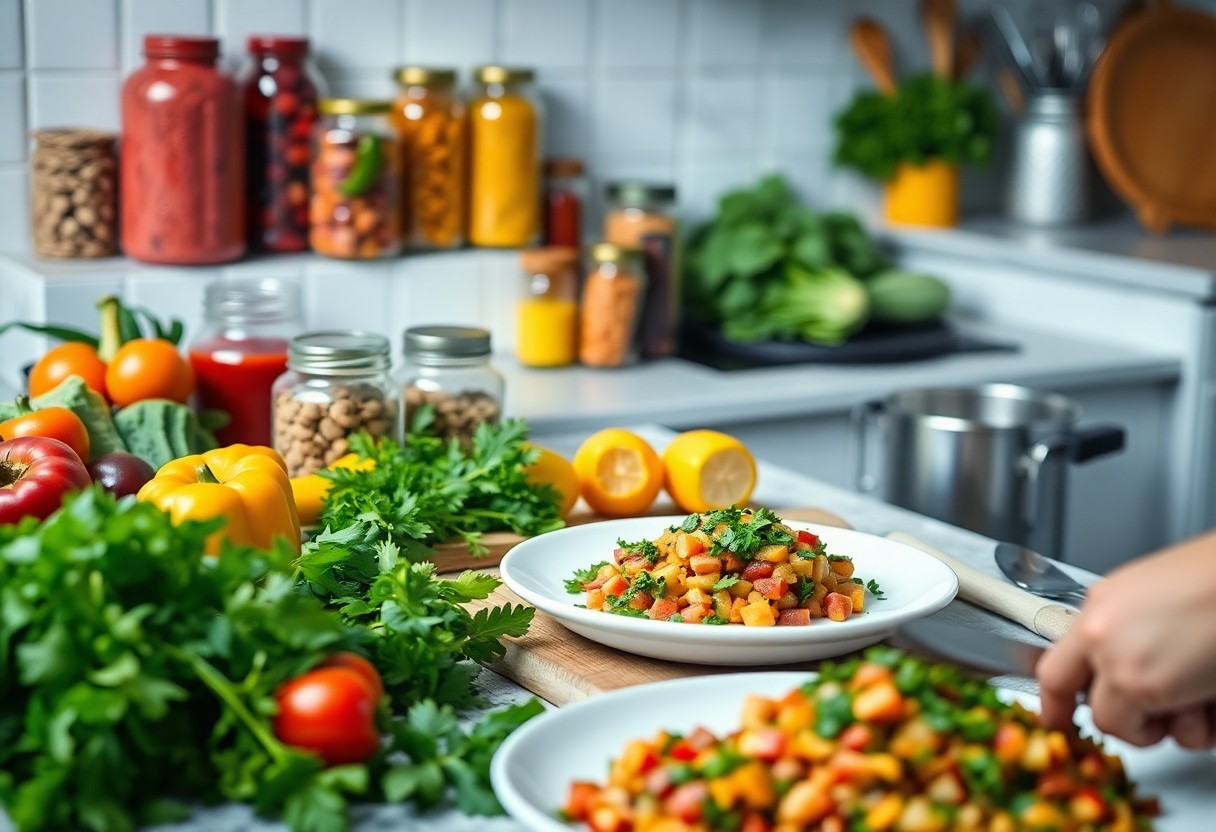Cooking healthy meals doesn’t have to be a challenge; with the right techniques, you can create flawless and flavorful dishes that nourish your body and delight your palate. By focusing on quality ingredients, mastering cooking methods, and adjusting seasonings, you can elevate your culinary skills while embracing a healthier lifestyle. In this guide, you will discover practical tips that will enhance your meals and help you enjoy the process, ultimately leading to delicious results you can be proud of!

Understanding Ingredients
The foundation of any delicious and healthy recipe lies in the quality of the ingredients you choose. To create meals that are not only flavorful but also nutritious, you must focus on selecting the best possible components. Understanding the properties and benefits of different ingredients can greatly enhance your cooking skills and overall meal quality. By getting familiar with various food groups and their nutritional values, you will be better equipped to make choices that promote your health without compromising on taste.
Selecting Fresh Produce
About selecting fresh produce, you want to keep a few key tips in mind to maximize flavor and nutritional content in your meals. Choose fruits and vegetables that are in season and locally sourced whenever possible; this often translates to enhanced taste and freshness. When shopping, look for vibrant colors, firm textures, and avoid any signs of bruising or blemishes. Utilizing farmers’ markets or organic stores can also guarantee that you’re purchasing the freshest options available.
Choosing Quality Protein Sources
At the same time, the protein sources you select play a pivotal role in the success of your healthy recipes. Focus on incorporating a variety of proteins such as lean meats, fish, legumes, nuts, and seeds into your diet. These options provide imperative amino acids while supporting your body’s needs for muscle health and overall well-being. When opting for protein sources, always prioritize those that are minimally processed to ensure maximum nutrient retention and avoid unnecessary additives that can detract from your cooking outcomes.
Further, seek out organic or grass-fed options when it comes to animal proteins, as they tend to possess higher levels of omega-3 fatty acids and lower levels of harmful contaminants. Additionally, incorporating plant-based proteins into your meals can offer distinct health benefits while adding unique flavors and textures. By making conscious choices about the proteins you consume, you can elevate your recipes to not only be more nutritious but also more satisfying on a flavor level.
Cooking Techniques
Any aspiring home chef understands that mastering cooking techniques is necessary for creating flavorful and healthy dishes. Different cooking methods can greatly influence both the taste and nutritional value of your meals. For example, certain techniques help preserve vitamins and minerals, while others can enhance flavors without extra fats or sugars. By focusing on your chosen cooking method, you can elevate your healthy recipes to new heights.
Sautéing vs. Steaming
An important distinction in the kitchen is between sautéing and steaming. Sautéing involves cooking food quickly in a small amount of oil over high heat, which can lead to flavorful caramelization and browning. This method is ideal for vegetables, as it enhances their natural sweetness and adds depth to their taste. On the other hand, steaming is a gentler technique that preserves the texture and nutrients of your ingredients while preventing the need for excess oil. Steamed vegetables often retain more vitamins, making them a valuable component of healthy meal preparation.
Baking Tips for Healthier Meals
Below are some effective baking tips that can transform your meals into healthier options, allowing you to enjoy your favorite flavors without compromising on nutrition:
- Opt for whole grain or alternative flours in your recipes.
- Utilize less sugar by incorporating natural sweeteners like honey or maple syrup.
- Reduce the amount of butter or oil by substituting with applesauce or avocado.
- Experiment with adding more fruits and vegetables to your baked goods.
The secret to baking healthier meals lies in making simple ingredient substitutions while being creative in your approach.
To ensure a well-rounded approach, it’s also important to know your baking times and temperatures. If a recipe calls for high heat, remember that cooking at a lower temperature longer can yield moist and tender results while keeping ingredients intact. Applying these techniques can significantly enhance flavor without resorting to unhealthy add-ins. Here are some tips:
- Use parchment paper to line your baking sheets for easy cleanup.
- Add spices and herbs for flavor without extra calories.
- Monitor your dishes closely to avoid overcooking or burning.
The results can certainly be remarkable! So get ready to enjoy delicious, healthy baked meals that everyone will love.
Flavor Enhancements
Clearly, the right flavor enhancements can elevate your healthy recipes from bland to brilliant. Incorporating ingredients that enhance taste without adding unnecessary calories or artificial additives is key to maintaining both flavor and health. By experimenting with various ingredients, you can discover combinations that not only fulfill your palate but also nourish your body, allowing you to enjoy the best of both worlds.
Herbs and Spices for Depth
Herbs are nature’s way of adding excitement to your dishes without the excess fat or sodium. Fresh herbs like basil, cilantro, and parsley can lend a vibrant freshness to salads and marinades, while dried herbs such as oregano and thyme can add depth to stews and roasted vegetables. As you cook, don’t hesitate to mix and match; the interplay of flavors can transform your everyday meals into gourmet experiences.
Using Natural Sweeteners
Between sugar and its many alternatives, finding a balance for sweetness in your recipes can significantly enhance the overall flavor without compromising health. Popular options like honey, maple syrup, and stevia provide not only sweetness but also unique flavors that can complement dishes beautifully. In baking, these natural sweeteners can bring moisture and balance to your ingredients, making even the healthiest of desserts feel indulgent.
Consequently, incorporating natural sweeteners into your cooking not only fulfills your cravings but also allows you to maintain better blood sugar levels. Unlike processed sugars, natural sweeteners often come with additional nutrients and antioxidants, enhancing your health while satisfying your taste buds. Be cautious with quantities; even natural sweeteners can affect your health negatively if consumed in excess. Ultimately, by using these wholesome alternatives, you will create dishes that are not only delicious but also nourishing.
Meal Prep Strategies
Many people find that having a plan is key to maintaining a healthy diet. Meal prep strategies can help you save time, reduce stress, and make healthful eating easier to achieve throughout the week. By preparing your meals in advance, you ensure that you have nutritious options readily available, which can help eliminate the temptation of unhealthy fast food or snacks when you’re busy or tired. Establish a routine that works for you by setting aside time each week to cook, portion, and store your meals, tailoring it to your lifestyle and preferences.
Batch Cooking for Health
After setting your meal prep schedule, one of the best approaches is to engage in batch cooking. This means cooking larger quantities of food in one go, which can then be divided into individual servings for the upcoming days. Choose recipes that feature superfoods and ingredients rich in nutrients, such as lentils, quinoa, and a variety of colorful vegetables. Not only does batch cooking save you time, but it also allows you to experiment with different flavors, making every meal exciting and nutritious. You can store different meals in your fridge or freezer, ready to grab at a moment’s notice.
Storage Tips for Freshness
To keep your prepped meals as fresh as possible, it’s necessary to focus on proper storage techniques. Start by using airtight containers to prevent air from spoiling your food and causing it to lose flavor and nutrients. Label each container with the date it was prepared, making it easier for you to keep track of freshness. Here are some key tips to keep in mind:
- Utilize glass containers whenever possible – they are non-toxic and provide a tight seal.
- Organize your fridge so that you consume older meals first; this will help reduce food waste.
- Always allow meals to cool down before refrigerating to avoid raising the fridge temperature.
Recognizing the impact of food safety can make a significant difference in your meal prep success. Be aware of the recommended refrigeration temperatures and expiration timelines to keep your meals not just convenient but also safe to eat.
With effective storage methods, you can enhance the longevity and taste of your prepared meals. Investing in quality containers and maintaining a good organization system will allow you to enjoy your healthy recipes at their best. Additionally, consider keeping track of your pantry necessarys and replacing items as needed. This proactive approach will ensure that you always have nutritious ingredients on hand when it’s time to prepare your meals. Recognizing the importance of storage and food safety habits will contribute to your overall meal prep success and satisfaction.
- Store items in the correct environment—the refrigerator for perishables and a cool place for dry goods.
- Check expiration dates regularly to avoid consuming outdated food.
- Utilize freezing meals for long-term storage, but be mindful of textures that may change.
Recognizing these strategies will not only make meal prep easier but will also enhance your overall eating experience.

Balancing Nutrition
Not all recipes are created equal when it comes to nutrition, which is why it’s important to focus on balancing the various components of your meals. By understanding how to combine different ingredients, you can create dishes that provide you with the vital nutrients your body needs. This not only supports your overall health but also enhances your cooking skills, allowing you to be more versatile in your kitchen creations.
Macronutrient Ratios
Balancing macronutrient ratios is key to achieving a wholesome diet. You should aim for a combination of proteins, carbohydrates, and fats that suits your lifestyle and health goals. For example, a balanced plate might consist of 30% protein, 40% carbohydrates, and 30% healthy fats. This ratio can help you stay energized, maintain muscle mass, and promote satiety, making it less likely that you will reach for unhealthy snacks throughout the day.
Incorporating Fiber-Rich Foods
Balancing your meals with fiber-rich foods will not only enhance their nutritional profile but will also help with digestion and keep you feeling full longer. Fiber plays a significant role in regulating your body’s functions and can aid in weight management. Including whole grains, fruits, vegetables, nuts, and seeds in your meals will provide you with the necessary fiber to support your digestive health.
For instance, adding a variety of colorful vegetables to your salads or stir-fries can significantly boost your fiber intake, while incorporating whole grains such as quinoa or brown rice can also make a big difference. Aim to fill half your plate with fiber-dense foods to maximize the benefits, and you’ll likely find that not only do you feel better, but your meals also taste more satisfying and fulfilling. This simple adjustment can transform the way you approach your meals and their impact on your overall health.
Creative Healthy Substitutions
Once again, making healthy decisions in the kitchen doesn’t mean sacrificing flavor or the joy of cooking. In fact, using creative healthy substitutions not only enhances the nutritional profile of your meals, but it can also inspire new culinary adventures. By thinking outside the box and reimagining common ingredients, you can craft dishes that taste just as delicious while fitting perfectly within your healthy lifestyle.
Swapping Ingredients for Health
Below are some simple swaps that can make a significant impact on the healthiness of your recipes. For example, instead of using white flour, try substituting it with whole wheat flour or almond flour, which adds fiber and important nutrients to your baked goods. You can also replace sugar with natural sweeteners such as honey, maple syrup, or even mashed bananas to reduce empty calories while adding moisture and flavor to your dishes. These small changes can lead to a more nutritious meal without sacrificing taste.
Plant-Based Alternatives
Across the culinary world, plant-based alternatives are not only gaining popularity but are becoming staples in creating healthy meals. Ingredients like cauliflower can serve as a fantastic substitute for traditional grains, and lentils can replace meat in various dishes, providing a rich source of plant protein. These swaps help you lower your intake of saturated fats while increasing your daily servings of vegetables.
It is important for you to explore the many benefits of incorporating plant-based foods into your diet. Not only do they tend to be lower in calories, but they are also packed with vitamins, minerals, and antioxidants that contribute to your overall health. Using options like avocado instead of mayonnaise can enrich a dish with healthy fats, while chickpeas blended into a creamy hummus offers a delightful, nutritious spread. By choosing plant-based alternatives, you can enjoy a flavorful twist on classic recipes while nourishing your body with wholesome ingredients.
To Wrap Up
Summing up, incorporating the right cooking tips into your routine can transform your meals into flawless and flavorful healthy recipes. By selecting fresh, high-quality ingredients and employing techniques such as proper seasoning and mindful cooking times, you will not only enhance the taste of your dishes but also elevate the nutritional value. Don’t hesitate to experiment with herbs and spices, as these can provide depth and character without adding unnecessary calories.
Moreover, consider your cooking methods; opting for grilling, steaming, or baking instead of frying can significantly impact your health outcomes. As you put these tips into practice, you will likely find that cooking healthily is not only achievable but also enjoyable. With each meal prepared, you are taking steps toward better health while indulging your taste buds. Embrace the process, and watch your culinary skills flourish as you whip up unforgettable, wholesome dishes in your kitchen.


